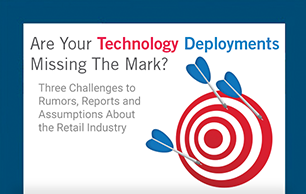Retail’s digital transformation is underway and there’s no turning back. As consumers get a taste of personalized, convenient, true omni-channel shopping, expectations are on the rise and tolerance for traditional, in-store shopping wanes.
But the digital transformation is so broad, so deep and so extensive that the process of selecting, prioritizing and deploying critical emerging technologies has become an extremely complex affair for retailers. In a survey from Riverbed, 47 percent of retailers say that brick and mortar stores have 3 years to adopt next generation digital technologies to stay competitive. At the same time, less than half of retailers say that their digital transformation strategy is well defined and being implemented. (Source: Software and PwC, “CEO Viewpoint 2017: The Transformation of Retail, 2017)
 Given the importance of this topic, Telaid took some time to dig into the trends and numbers surrounding the digital transformation of retail. We found that - in many ways - retailers are pioneering unknown territory as they deploy emerging technologies without full knowledge of how they may change their businesses or integrate with other solutions. What they do know is that the real-time insight, precision tracking, and customer data enabled by these technologies is a must-have for retailers that plan to persist in 2020 and beyond.
Given the importance of this topic, Telaid took some time to dig into the trends and numbers surrounding the digital transformation of retail. We found that - in many ways - retailers are pioneering unknown territory as they deploy emerging technologies without full knowledge of how they may change their businesses or integrate with other solutions. What they do know is that the real-time insight, precision tracking, and customer data enabled by these technologies is a must-have for retailers that plan to persist in 2020 and beyond.
We invite you to read Navigating the Digital Transformation in Retail: Some Insights, Goals and Tips to get a complete perspective on drivers, challenges, contradictions and opportunities associated with the digital transformation. The next step is to prepare to advance your plans for digital transformation. Here are some recommendations for successful pursuit of your business strategy around digital transformation.
- Start with the business case, ROI analysis and prioritize technology adoption according to the business case. To achieve success, it’s imperative to base technology selection on your own business objectives as opposed to “what other retailers are doing.”
- Assess your physical layer infrastructure and upgrade it as needed to support new technologies. This basic “blocking and tackling” step is so obvious, but often overlooked with devastating consequences.
- Extend your IT team with experienced technology resources that can offer deployment capabilities and ongoing technology lifecycle support. Technologies are advancing at light speed and no internal department has enough time and resources to handle everything on their own.
- Ensure you have back-up, redundancy in place to support operations in case of an emergency. Downtime can be devastating in retail. Taking time to make a redundancy plan is critical.
By taking these steps, you can improve your chances of accomplishing the digital transformation successfully, with fewer delays, rework and unexpected expense. The time is now to move forward. Are you ready?




